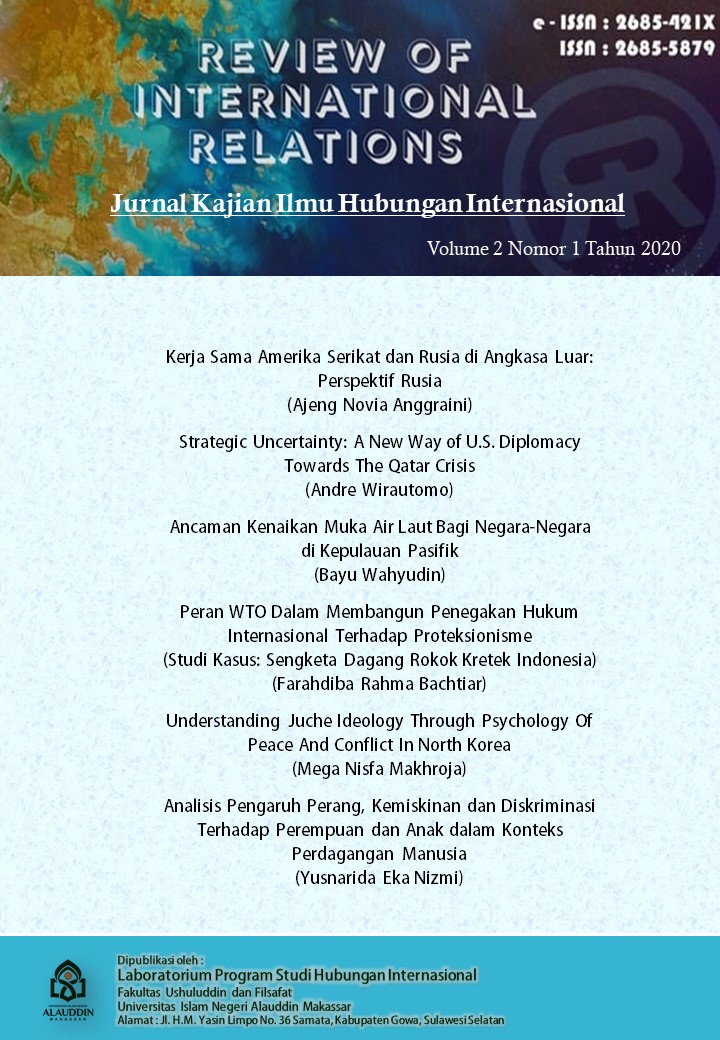ANALISIS PENGARUH PERANG, KEMISKINAN DAN DISKRIMINASI TERHADAP PEREMPUAN DAN ANAK DALAM KONTEKS PERDAGANGAN MANUSIA
Abstrak
This study aims to describe the unhappiness of being women and children since human trafficking crimes dissapear their lives that driven by war, poverty and discrimination. There are various casualities that trigger human trafficking and the involvement of trafficker in this humanity crime. This study reviews various literatures since library research is the method of this research. This research analyzes the concept of war, poverty, and domestic conflict. Women and children become vulnerable target to be smuggled illegally to destination countries. Many of them finally end up in torture, violance and sexual exploitation. They have to keep working with minimum salary just for paying transportation cost. For smugglers, these vulnerable people are potential target to get money from selling them to other person or group. The smugglers lied to them about the truly motives and for the victims, the cost and exploitation are the consequences to reveal all their the horrible conditions. This research shows that how women and children start their sad journey since devastated and insecure in the neighbourhood because of war, domestic conflict and never ending poverty##plugins.generic.usageStats.downloads##
Referensi
Bales, K. (2002). Because she looks like a child. In: Global Woman: Nannies, Maids, and Sex
Workers in the New Economy, ed. Barbara Ehrenreich and Arlie Russell Hochschild,
Henry Holt, New York.
Beccaria, C. (1819). On Crimes and Punishment, trans. Edward D. Ingraham, 2nd ed., Philip
H. Nicklin, Philadelphia.
Bentham, J. (1967). A Fragment on Government and an Introduction to the Principles of
Morals and Legislation, Basil Blackwell, Oxford.
Chambliss W. dan M. Mankoff. (1976).Whose Law? What Order? A Conflict Approach to
Criminology, John Wiley and Sons, New York.
Durkheim, E. (1964). Division of Labor in Society, Free Press, New York.
Ehrenreich, B. (2002). Maid to Order. In: Global Woman: Nannies, Maids, and Sex Workers
in the New Economy, ed. Barbara Ehrenreich and Arlie Russell Hochschild,
Henry Holt, New York.
Hirschi, T. (1969). The Causes of Delinquency, University of California Press, Berkeley.
Huda, S.(2005). Human trafficking: Expert on trafficking in persons end visit to Lebanon,
http://www.humantrafficking.org/collaboration/regional/ame/news/2005_
/expert_statement.
Lan, P. (2002). Among women: Migrant domestics and their Taiwanese employers across
generations. In: Global Woman: Nannies, Maids, and Sex Workers in the New
Economy, ed. Barbara Ehrenreich and Arlie Russell Hochschild, New York: Henry
Holt, New York.
Krasmigi,E. (2005). ISN Security Watch, http://www.humantrafficking.org/collaboration/
regional/ seur/news/2005_09/combating.htm.
McCaghy, C. (1980).Crime in America, Free Press, New York.
Merton, R. K. (1968). Social Theory and Social Structure, Free Press, New York.
More, T. (1949). Utopia, trans. H.B.S. Ogden, Appletone-Century Crofts, New York,
Parrerias, R.S. (2002). The care crisis in the Philippines: Children and transnational families
in the new global economy. In: Global Woman: Nannies, Maids, and Sex
Workers in the New Economy, ed. Barbara Ehrenreich and Arlie Russell Hoch
schild, Henry Holt, New York.
Quinney, R. (1977). Class, State and Crime: On the Theory and Practice of Criminal Justice,
David McKay, New York.
Richard, A.O. International Traἀ cking in Women in the United States: A Contem
porary Manifestation of Slavery and Organized Crime, Center for the Study of
Intelligence, Washington, D.C., 2000.
Torstein,M. (1996). Child Slavery: Nigerian Human Rights Group Reporting, Press Digest,
Lagos, Nigeria.
##submission.copyrightStatement##
##submission.license.cc.by-sa4.footer##









